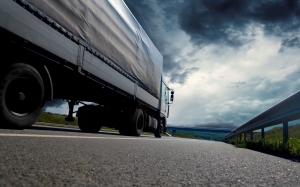 Driver safety is always at the forefront of a fleet manager’s mind, and high-tech innovations have led to an explosion of new safety features for trucks. With millions of commercial vehicles hauling cargo at a rate of 2000-3000 miles per week, the industry can’t afford to overlook opportunities to improve safety. Basic safety features such as seatbelts and airbags are a good start, but modern improvements take safety to the next level.
Driver safety is always at the forefront of a fleet manager’s mind, and high-tech innovations have led to an explosion of new safety features for trucks. With millions of commercial vehicles hauling cargo at a rate of 2000-3000 miles per week, the industry can’t afford to overlook opportunities to improve safety. Basic safety features such as seatbelts and airbags are a good start, but modern improvements take safety to the next level.
Radar systems in combinations with outward-facing cameras allow new safety features to reduce the likelihood of accidents while keeping drivers safe behind the wheel. The following are some of the most advanced features available in trucking safety:
- Adaptive cruise control. Setting the cruise control allows drivers to maintain their speed and reduce the aches the come with constantly adjusting the gas and brake pedal while driving for several hours. However, other motorists on the road don’t always make cruise control a useable feature as they speed up and slow down. Adaptive cruise control technology can adjust the speed of the truck to account for other passenger vehicles on the road to slow down when necessary to maintain a safe following distance.
- Blind spot detection. A common frustration for truck drivers is motorists riding in their blind spots. With sensors and cameras, modern technology can alert the truck driver of anyone in their blind spot and instruct them to avoid changing lanes or making turns until the individual clears out of their path.
- Rain and light sensors. Windshield wipers and headlights are vital for navigating in rainy or foggy conditions. However, truck drivers have a lot to monitor and it isn’t always easy to take their hands off the wheel to turn on lights or engage wipers. Smart sensors can detect the presence of rain or dim lighting to trigger these features automatically when necessary.
- Detecting traffic signs. It’s not difficult to miss roadside signs while driving. The truck driver may be checking his or her mirror to change lanes or glancing at their dashboard to check their speed limit and zip by important signage. Radar, sensors, and cameras can all keep a lookout and alert drivers to changes in speed limits, upcoming roadwork, accidents ahead, and more.
- Detecting and avoiding pedestrians. Pedestrians always have the right of way, but they can make unsafe decisions when darting out into the road to beat traffic. Innovators have managed to improve sensor sensitivity and distance to detect people in addition to other motorists. This allows the technology to engage the brakes and issue an audible warning to the driver to allow him or her to navigate around the human hazard while avoiding a collision.
Finding ways to improve driver safety is critical for all fleets. While improving technology certainly helps, fleets can look at their own data and metrics to find ways to reduce risks. Utilizing telematics can show fleet managers ways to identify risky driver behaviors, truck equipment and parts that need replacing or servicing, and other methods of improving driver safety. Contact the experts at DriverCheck to learn more about how telematics can boost your fleet’s safety ratings.